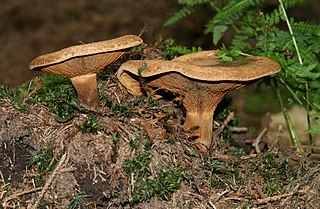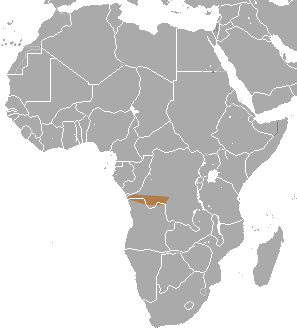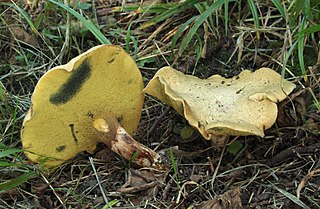
The Democratic Republic of the Congo is a country in Central Africa. By land area, the DRC is the second-largest country in Africa and the 11th-largest in the world. With a population of around 112 million, the Democratic Republic of the Congo is the most populous Francophone country in the world. The national capital and largest city is Kinshasa, which is also the economic center. The country is bordered by the Republic of the Congo, Central African Republic, South Sudan, Uganda, Rwanda, Burundi, Tanzania, Zambia, Angola, the Cabinda exclave of Angola, and the South Atlantic Ocean.

The quadriceps femoris muscle is a large muscle group that includes the four prevailing muscles on the front of the thigh. It is the sole extensor muscle of the knee, forming a large fleshy mass which covers the front and sides of the femur. The name derives from Latin four-headed muscle of the femur.

The genus Phenacomys is a group of North American voles. The genus name comes from the Greek for "imposter mouse."

The western heather vole is a small vole found in western North America. Until recently, the eastern heather vole,, was considered to be a subspecies. They have short ears with stiff orange hair inside and a short thin tail which is paler underneath. Their long soft fur is brownish with silver grey underparts. They are roughly 14 cm (5.5 in) long with a tail length shorter than one-half their body length, approximately 50 mm (2.0 in). They weigh about 40 g (1.4 oz).

The vastus intermedius (Cruraeus) arises from the front and lateral surfaces of the body of the femur in its upper two-thirds, sitting under the rectus femoris muscle and from the lower part of the lateral intermuscular septum. Its fibers end in a superficial aponeurosis, which forms the deep part of the quadriceps femoris tendon.

The Paxillaceae are a family of mushroom-forming fungi bearing close affinity to the boletes. Collectively, the family contains nine genera and 78 species. The type genus is Paxillus, containing fungi with decurrent gills, and Gyrodon, which has members with decurrent pores, among others. French mycologist René Maire had erected the family in 1902, placing it between the agarics and boletes and recognizing the groups' similarities with the latter group. Maire's usage of the name was later deemed to be invalid, and the genus authority is attributed to Johannes Paulus Lotsy. Molecular research confirms the relations of Gyrodon, with the decurrent-pored mushroom G. lividus, Paragyrodon, with the type species P. sphaerosporus, and Paxillus as sister groups, together lying near the base of a phylogenetic tree from which the genus Boletus arises. The name Gyrodontaceae, published by Belgian botanist Paul Heinemann in 1951, is considered synonymous with Paxillaceae.

The terrestrial brownbul is a species of songbird in the bulbul family, Pycnonotidae. It is found in eastern and south-eastern Africa. Its natural habitats are subtropical or tropical dry forest, subtropical or tropical moist lowland forest, and subtropical or tropical moist shrubland.

Hayman's dwarf epauletted fruit bat or Hayman's epauletted fruit bat is a species of megabat in the family Pteropodidae. It is found in Angola and Democratic Republic of the Congo. Its natural habitats are subtropical or tropical moist lowland forest and moist savanna.

Gyrodon lividus, commonly known as the alder bolete, is a pored mushroom bearing close affinity to the genus Paxillus. Although found predominantly in Europe, where it grows in a mycorrhizal association with alder, it has also recorded from China, Japan and California. Fruit bodies are distinguished from other boletes by decurrent bright yellow pores that turn blue-grey on bruising. G. lividus mushrooms are edible.

Gyrodon is a genus of pored mushroom bearing close affinity to the genus Paxillus. Recent molecular research has confirmed this relationship of the two genera as sister taxa, together diverging as one of the most basal lineages in the Boletineae, and sister to the Boletaceae.

The Republic of the Congo is a country located on the western coast of Central Africa to the west of the Congo River. It is bordered to the west by Gabon, to the northwest by Cameroon, to the northeast by the Central African Republic, to the southeast by the Democratic Republic of the Congo, to the south by the Angolan exclave of Cabinda, and to the southwest by the Atlantic Ocean.
Trachyglanis intermedius is a species of loach catfish endemic to the Democratic Republic of the Congo where it is found in the Lulua River. It grows to a length of 9.0 cm.
Raiamas intermedius is a species of ray-finned fish in the genus Raiamas which is found in the Democratic Republic of the Congo and Zambia.

Charaxes lucretius, the violet-washed charaxes or common red charaxes, is a butterfly in the family Nymphalidae.

Boletinellus merulioides, commonly known as the ash-tree bolete, is a species of bolete fungus in the family Boletinellaceae. Described as new to science in 1832, it is found in Asia and eastern North America, where it grows on the ground near ash trees.
Gyrodon crassipes is a bolete mushroom described in 1983 from Ethiopia. it has a cinnamon-coloured cap that turns black-brown to touch, decurrent gills and a brown stem.
Gyrodon miretipes is a bolete mushroom described in 1983 from Burundi. it has a red-brown cap and stipe, and yellow-tan decurrent gills.
Gyrodon tennesseensis is a bolete fungus in the family Paxillaceae. It was originally described in 1940 by Wally Snell and Alexander H. Smith as a species of Boletus. Snell and Hesler transferred it to Gyrodon a year later. It is found in the United States and Canada.
Obelistes intermedius is a species of leaf beetle of the Democratic Republic of the Congo. It was first described by the Belgian entomologist Louis Jules Léon Burgeon in 1941.
Stiphropus is a genus of crab spiders in the family Thomisidae, containing twenty one species from Africa and Asia.











